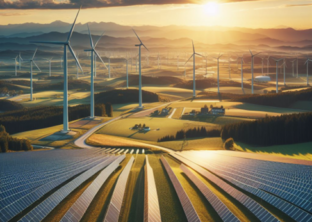Energy supply and price development – influences and effects
The „German Angst“ is sweeping Germany and Europe. German consumers in particular are rushing into electricity-based heating devices such as infrared heaters, radiators and wood-burning stoves as if there were no tomorrow. On the one hand, it is understandable that people do not want to sit in the cold in winter, but many do not consider that it is precisely the electric radiators and hot-water boilers that consume a lot of electricity. And electricity, like all other energy sources, is becoming more and more expensive.
This brings us to the real issue – the ever-increasing energy prices. Heralded by the Ukraine war, the misguided energy policies of past governments have put Germany in severe straits. Harmonised inflation (calculated according to European standards) is provisionally put at 8.5 percent for July 2022 by the German Federal Statistical Office, while in the eurozone inflation reached a record 8.9 percent, according to Eurostat. The main driver of these developments is the high energy price, which rose by a further ~40 percent in July compared to the previous month, although the increase slowed down somewhat compared to June.
Development of energy prices in Germany since June 2021 to June 2022
The enormous price increases since summer 2021 can be attributed to concerns about a very tense supply situation (e. g. Nord Stream II, Ukraine war). There is currently no end in sight.

Source: Statistisches Bundesamt, 2022 (Indices, 2015 = 100)
The question we are all asking ourselves is whether the natural gas supply will remain guaranteed in the coming months or whether Putin will turn off the tap. And this continues to drive up energy prices; solutions for private households and industry are being worked on frantically. Germany’s high dependence on natural gas in industry (in 2020, natural gas was the most important energy source in industry with 31.2 percent) and private households (in 2019, 41.2 percent of residential energy was covered by natural gas) is ruining the possibilities of quickly obtaining new and sufficient energy sources by winter 2022.
Liquefied natural gas terminals on Germany’s coasts are suddenly being approved in a rush and in some cases already being built, new supply agreements are being concluded, renewable energy sources are being pushed and interim solutions of coal-fired power generation instead of natural gas or the extension of the lifetimes of nuclear reactors are being discussed. Savings programmes for natural gas are becoming louder and louder and it can already be observed that less is being consumed – both by private households and industry. An emergency plan to reduce gas consumption was adopted in Brussels at the end of July, in which the EU states voluntarily commit to reducing gas consumption by 15 percent between 1 August 2022 and 31 March 2023 compared to their average consumption over the last five years.
The Spanish government has already taken action on this and will adopt a package of energy-saving measures next week, valid until 1 November 2023. Under this package, public institutions, department stores, workplaces, hotels, train stations and airports will not be allowed to cool their air-conditioning systems to less than 27° C and will not be allowed to heat them to more than 19° C in winter. Lighting is also to be switched off from shop windows, monuments and offices from 10 pm and doors are generally to be kept closed. In Germany, cities and municipalities as well as industry are also active with individual measures to save energy, but there are no overarching binding approaches „yet“.
A German emergency plan provides for households and critical facilities such as hospitals to be supplied with gas as a priority, while industry would be the first to be affected by rationing. This is causing a lot of trouble for industry; everyone is trying to emphasise their relevance and importance to the government in order not to be rationed first.
Our vulnerability is also shown by the case of Uniper, which the German government has now saved from insolvency with financial support. It took just two weeks for Germany’s first gas importer to run into difficulties. A bankruptcy would have caused hardship for many municipal utilities, and end customers would no longer have been supplied with gas.
The problem for Uniper is the legal situation in Germany, which regulates the passing on of higher prices to consumers. As a result, Uniper could not pass on the costs to the municipal utilities and was faced with financial distress. The government has defused this situation with its intervention, but the costs will eventually be passed on to the municipal utilities and thus to the end consumers. An end to the price increase has not yet been reached.
It can be assumed that the trend of energy price increases will continue this year. It will probably not be clear until the beginning of winter whether the uncertainties will persist and whether further price increases are to be expected. In the medium term, we in Germany and Europe will have to put our energy supply on a completely new footing, which on the one hand will lead to overall higher costs for households and industry that we will have to live with, but on the other hand will also support new investments that can, for example, give the domestic wind and solar industry a new boost in the longer term.
Silke Hänisch, Market Intelligence Senior Expert
Sources:
- ifo Institut, Statistisches Bundesamt, Eurostat, EU Kommission, RedaktionsNetzwerk Deutschland, Reuters







